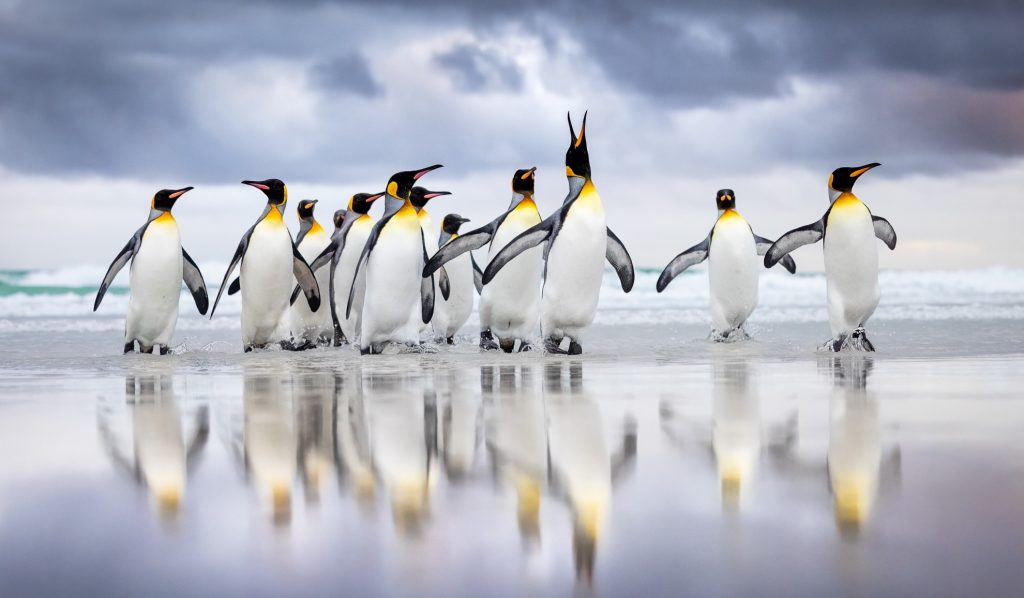On April 8, 2024, a total solar eclipse mesmerized North America. On a boat off the Pacific coast of Mexico, photographer Liron Gertsman readied his Canon EOS R5 to capture the image of a lifetime. Thankfully, the local birds cooperated.
“I spent well over a year of planning to capture my dream of a bird in front of the total solar eclipse,” Gertsman said in a statement. “I enlisted the help of a boat to position myself near some islets off Mazatlán that were frequented by seabirds. As the moon uncovered the sun’s edge at the end of totality, I captured this image during the eclipse phase known as the ‘diamond ring’ – a moment that lasts mere seconds.”
The image (seen below), titled “The Frigatebird and the Diamond Ring,” took home top honors at the 2025 Bird Photographer of the Year awards.
BIRDS IN FLIGHT, GOLD AWARD AND BIRD PHOTOGRAPHER OF THE YEAR 2025
After well over a year of planning and about a week of in-person scouting on the coast of Sinaloa in Mexico, my dream of capturing a bird in front of a total solar eclipse finally came true on April 8, 2024. Totality was due to last almost 4.5 minutes, and I had enlisted the help of a boat to position myself near some islets off Mazatlán that were frequented by seabirds. As the moon uncovered the sun’s edge at the end of totality, I captured this Magnificent Frigatebird in front of the spectacular eclipse phase known as the ‘diamond ring’, a moment that lasts just seconds.
Credit: © Liron Gertsman / BIRD PHOTOGRAPHER OF THE YEAR 2025 Liron Gertsman
Photographers from around the world submitted more than 25,000 images across eight primary categories: Best Portrait, Birds in the Environment, Bird Behaviour, Birds in Flight, Black and White, Urban Birds, Conservation (Single Image), and Creative Perspectives. Prizes were also handed out for portfolio and video, along with honors for young bird photographers.

CONSERVATION (SINGLE IMAGE), BRONZE AWARD
The Greater Adjutant is a Near Threatened species with a population of fewer than 1,500 mature individuals left in the wild. It was very sad to see such a rare bird struggling for food at this rubbish dump.
Credit: © Hira Punjabi / BIRD PHOTOGRAPHER OF THE YEAR 2025

BIRD BEHAVIOUR, GOLD AWARD
A Red Deer killed by a car in the pine forest near to where I live provided a fantastic opportunity to document the activity of carnivores and scavengers visiting the carcass. With the help of a friend I positioned and camouflaged a motion sensor and two mirrorless cameras nearby. To avoid any disturbance I avoided the use of flashes or any other type of artificial light. After foxes, crows and some small birds had paid a visit, most unexpectedly, and despite the thick blanket of branches, a Golden Eagle appeared and descended to feed on the carcass. It was an unforgettable experience.
Credit: © Francesco Guffanti / BIRD PHOTOGRAPHER OF THE YEAR 2025

BIRDS IN THE ENVIRONMENT, GOLD AWARD
I was in the Sea of Cortez, near Los Islotes, a fistful of rocks that is part of the Espíritu Santo archipelago, to document the unbelievable recovery of this marine protected area. Los Islotes is the southernmost breeding site of the Californian Sea Lion in the Northern Hemisphere, but it is a wonderfully wild place for many other reasons. I was fascinated by the extraordinary skills and elegance of Brandt’s Cormorants as they fed on an almost endless school of small pilchards. Most of the hunting activities took place at sunset, when the low natural light conditions were challenging. But on one occasion the conditions were favourable and I was able to take this particular image that gives a three- dimensional perspective.
Credit: © Franco Banfi / BIRD PHOTOGRAPHER OF THE YEAR 2025

CONSERVATION (SINGLE IMAGE), GOLD AWARD
This pictured is of an injured juvenile Common Hawk-Cuckoo that had been rescued after being hit by a vehicle in the city. The bird had taken shelter under a parked car before being rescued by the ManwithIndies Foundation and sent for treatment under the forest department’s guidance. To assess the damage to its wings, a radiograph was obtained after anesthetising the bird. Common Hawk-Cuckoos are brood parasites, laying their eggs in the nests of smaller urban birds like sunbirds, prinias, and tailorbirds. While these smaller birds have adapted well to urban environments, the much larger hawk-cuckoo struggles to navigate and survive. Every year, several cuckoo chicks are found under similar circumstances, and foundations like ManwithIndies rescue many of them.
Credit: © Sarthak Agrawal / BIRD PHOTOGRAPHER OF THE YEAR 2025 ADINATH

CREATIVE PERSPECTIVES, BRONZE AWARD
This photo is of a Buffy Fish Owl perched atop a street light, a frequent spot from which these birds hunt. The contrast between the dark night sky and the bright light results in the owl going unnoticed by most passersby. To capture a unique perspective, I positioned myself directly beneath the bird, using a wide-angle lens and pointing my camera upwards. The lamp post serves as a leading line, drawing attention to the owl centred in the frame. The street light and treetop branches create a striking blend of urban and natural elements, highlighting the owl’s adaptability to urban life.
Credit: © Jim Lee / BIRD PHOTOGRAPHER OF THE YEAR 2025

BIRD BEHAVIOUR, SILVER AWARD
This male capercaillie, illuminated by the first rays of the rising sun, had perched in the ideal spot. The emotions I felt are hard to put into words. Overwhelmed by the scene, I forgot to adjust my camera settings, resulting in most of the photos being blurry. Thankfully, though, a few turned out sharp!
Credit: © Mateusz Piesiak / BIRD PHOTOGRAPHER OF THE YEAR 2025

BIRD BEHAVIOUR, BRONZE AWARD
When a male Asian Houbara (also known as Macqueen’s Bustard) performs his courtship dance, he puffs out his beautiful white breast feathers and starts running around, usually in a prominent place – all in order to attract a mate. This bustard is normally very shy and difficult to see due to its wonderfully cryptic plumage. For this reason, the best time to photograph these birds is during the breeding season when the males are displaying. For many years I have dreamed of photographing a bustard dancing in the desert and finally, with a lot of patience and a stroke of luck, I managed to approach one slowly until I got close enough to capture him strutting his stuff.
Credit: © Chen Ein-Dor / BIRD PHOTOGRAPHER OF THE YEAR 2025

BIRD PORTRAIT, SILVER AWARD
After the devastating wildfires of summer 2024, I visited Jasper to witness the desolation. In the scorched landscape, where ash covered everything, only a few animals had returned. Among them, Common Ravens were some of the first to reclaim the land. This one, perched on a charred tree, was calling out, as if mourning the loss of its kingdom.
Credit: © Maxime Legare-Vezina / BIRD PHOTOGRAPHER OF THE YEAR 2025 Maxime Legare-Vezina

BIRD PORTRAIT, BRONZE AWARD
I was photographing a small flock of Alpine Choughs at 2,300 metres in the Swiss Alps when the temperature dropped to a biting −10°C and the wind whipped snow across the ground in swirling gusts. Yet the choughs, perfectly adapted to these harsh conditions, seemed completely unfazed as they hopped around, searching for scraps left behind by tourists. I loved watching them as they flew and moved through the blizzard in a truly elegant way.
Credit: © Luca Lorenz / BIRD PHOTOGRAPHER OF THE YEAR 2025

CONSERVATION (SINGLE IMAGE), SILVER AWARD
In heartbreaking contrast to its wild peers, this Shoebill stork is confined in a small dirty cage in a zoo in Entebbe, Uganda. Known for their solitary and elusive nature, Shoebills thrive in vast wetlands, hunting in silence and flying gracefully over open landscapes. Here, trapped behind glass for the entire day and on full display to the public, this majestic bird is deprived of space to fly, hunt or retreat from the constant gaze of visitors. Just a few miles away its wild counterparts enjoy the freedom of Uganda’s marshes – a stark reminder of the unnatural conditions that captivity imposes on such extraordinary creatures.
Credit: © Charlotte Keast / BIRD PHOTOGRAPHER OF THE YEAR 2025

URBAN BIRDS, SILVER AWARD
Eurasian Jays are not generally thought of as urban birds but can sometimes be found in parks and gardens. They almost always build their nests in trees, avoiding artificial structures – so when a friend reported finding a jay’s nest inside (!) a streetlamp I considered it a joke; the Eurasian Jay is not a hole nester. Yet I could not resist checking it out and to my amazement the nest was real. I waited for the ‘blue hour’ to combine the warm light from the lamp with the cold colours of this unique nest’s surroundings before taking this photo.
Credit: © Tomáš Grim / BIRD PHOTOGRAPHER OF THE YEAR 2025 Tomas Grim

BEST PORTRAIT, GOLD AWARD
Giant petrels are the scavengers of the Southern Ocean, often seen feeding on carrion. This individual has its head stained red with blood from a recent meal. Although their feeding habits may seem gruesome, these birds play a vital role in the ecosystem by preventing the spread of disease. Despite their appearance, giant petrels are surprisingly devoted parents, with both males and females taking turns incubating their single egg and guarding their chick for weeks. Once heavily persecuted for their oil, their populations have rebounded thanks to conservation efforts, although they still face threats from fishing practices and climate change.
Credit: © Steffen Foerster / BIRD PHOTOGRAPHER OF THE YEAR 2025

URBAN BIRDS, BRONZE AWARD
This disused French chapel was occupied by Barn Owls who had no flat surfaces on which they could nest. So I installed a nest box inside and was surprised and delighted when, a year and a half later, a pair settled in and bred successfully. The photo was taken from my hide tent at dusk, the light coming from the street lamps that had just been turned on.
Credit: © Benoit Henrion / BIRD PHOTOGRAPHER OF THE YEAR 2025


